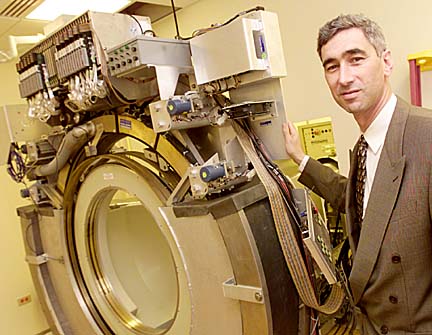


Full-body scan BLOCKED CORONARY ARTERIES and deadly cancers silently developing in the body can be detected now within minutes and without pain years before symptoms appear.
Potentially deadly diseases can
now be found much earlier using a new
Electron Beam Tomography scannerBy Helen Altonn
haltonn@starbulletin.comElectron Beam Tomography scanning is the newest weapon in Hawaii's disease-fighting arsenal.
The $2 million scanner -- the only one in the state -- belongs to Holistica Hawaii Health Center in the Hilton Hawaiian Village. It is acclaimed as the "gold standard" in detecting plaque within heart arteries, indicating arteriosclerosis or heart disease.
Dr. Fred Pashkow, medical director of the Queen's Medical Center's Heart Institute and author of "The Woman's Heart Book," plans to see his preventative cardiology patients at Holistica and do some consulting there.
He said Queen's cardiologists are "becoming real believers" in the EBT, which is "very, very clever at finding calcium in the body," including places such as the heart, where it doesn't belong.
To avoid claustrophobia, the machine is open so the person can look up and out to the sides while lying fully clothed on a table moving through the scanner.
A HEART SCAN takes about seven minutes and a full-body scan about 20 minutes. A scan involves a rapid series of 3-D photographs at 50 to 100 milliseconds per exposure.
"It's really incredible," said Dr. Matthew J. Budoff, assistant professor of medicine and director of Electron Beam Tomography at the University of California-Los Angeles School of Medicine. "The actual images, the data we get, are incredibly diagnostic."
A guinea pig for EBT tests many times, Budoff said the beauty of the technique is that it's safe and noninvasive, requiring no injections. It's 10 times faster than traditional scanners and looks at anatomy rather than blood flow, he said.
Budoff was here recently giving symposiums on the technology to physicians at Holistica and Queen's.
He was one of the first cardiologists testing the ultrafast/electron beam CT (computerized tomography) scan after it was developed in 1985 at the University of California-San Francisco. He has led a team investigating the technology for 15 years.
Budoff said the EBT is proven to detect early plaque buildup, arterial blockages, early lung cancer and developing tumors.
It also uncovers developing pancreatic and kidney cancers, early signs of osteoporosis and other disorders.
Holistica Hawaii opened Oct. 24 last year in Alii Plaza at the Hawaiian Village. It performed more than 5,000 scans on 1,400 clients before it closed Aug. 1 to move to more spacious quarters in the Kalia Tower, said spokesperson Robyn A. Schaefer.
The new facility will open Sept. 14 as part of a wellness center.
"When we at Queen's first heard about this idea, we were intrigued," Pashkow said, pointing out everything is there for fitness conditioning, "and we're trying to get people to do this every day of their lives."
Also, he said, the resort setting is more appropriate for a prevention program than a hospital because "hospitals are designed to take care of sick people, not well people."
Scans are immediately followed by consultation with a physician or medical specialist, Schaefer said. Clients receive CD-ROMs with all images and test results which they can take to their doctor.
KAMAAINA CAN GET a full-body scan for $1,095 and a heart scan for $495. For nonresidents the cost is $1,215 for a full scan and $550 for the heart.
Insurance doesn't cover the preventative procedure, but Budoff expects that to change as it becomes more accepted.
As a sample of Holistica Hawaii's cases:
>> A heart scan disclosed that a 59-year-old emergency physician, an avid hiker, had calcium buildup putting him at risk for heart disease. Cardiac angiography, used after an EBT scan to highlight the inside of the arteries and arterial tubes, revealed 60 percent blockage of his arteries.
>> A full-body scan for a 35-year-old man showed one of his kidneys was in his pelvis. Because he's a kickboxer, a blow to that area could cause serious injury or death, so the doctor suggested he use more protective gear or take up a different hobby.
Early detection of heart, stroke and lung cancer -- top causes of death -- as well as cancers of other organs "will be of incredible value," Budoff said.
Pashkow also stressed that some cancers are hard to find, such as pancreatic and lung cancer. "When they pop up, it's almost too late," he said. "But this machine will find these tumors very, very early, and they can be managed appropriately."
Explaining there are ways to reverse the No. 1 killer -- heart disease -- Budoff said, "It's very important to find out who's walking around with plaque in their arteries" and not wait for a heart attack.
"Once he has read about it, a cardiologist realizes this is the mammogram of the heart, and it doesn't miss anything."